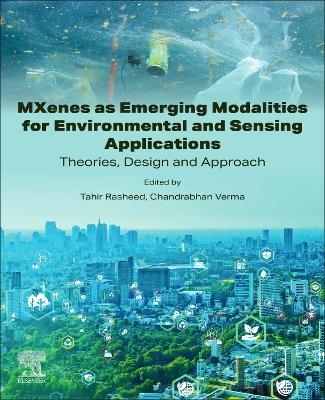
MXenes as Emerging Modalities for Environmental and Sensing Applications
Elsevier - Health Sciences Division (Verlag)
978-0-443-21853-8 (ISBN)
Tahir Rasheed is a researcher at the Interdisciplinary Research Center for Advanced Materials, King Fahd University of Petroleum and Minerals, Saudi Arabia. His research interests focus on multiple disciplines including controllable synthesis, characterization and self-assembly of polymeric materials, polymer-based composites, nanomaterials and nanocomposites, and hybrid nanocomposites, with special emphasis on their potential applications in the field of sensing and biosensing, electrocatalysis, and the degradation and quantification of various emerging pollutants. Chandrabhan Verma, PhD, works at the Interdisciplinary Research Center for Advanced Materials, King Fahd University of Petroleum and Minerals, Dhahran, Saudi Arabia. He is a member of the American Chemical Society (ACS). His research interests mainly focus on the synthesis and design of environment-friendly corrosion inhibitors used for several industrial applications. Dr. Verma received his PhD degree from the Department of Chemistry at IIT?BHU, Varanasi, India and MSc degree in organic chemistry (Gold Medalist). Dr. Verma is the author of several research and review articles in peer-reviewed international journals. He has also received several national and international awards for his academic achievements.
Part 1: BASICS and FUNDAMENTALS 1. MXenes: Fundamental, Properties, Classification and Application 2. MXenes and Hydride Nanostructures: Fundamental, Properties, Surface Modification, Properties and Application 3. Detection and Purification of Toxic Materials: Past and Present Advancements and Role of MXenes Part 2: MXENES IN ENVIRONMENTAL APPLICATION 4. Theories of Identification and control of Environmental Toxic Materials: Chronological Growth and MXenes as Ideal Substitute 5. MXene as a Solution to Clean Ecosystem in a Sustainable Way 6. MXene-based hybrid Nanostructures for Detection and Purification of Toxic Gases 7. MXene-based hybrid Nanostructures for Detection and Purification of Heavy Metals 8. MXene-based hybrid Nanostructures for Detection and Purification of Toxic Ions and Radionuclides 9. MXene-based hybrid Nanostructures for Detection and Purification of Organic and Inorganic Pollutants 10. MXene-based hybrid Nanostructures for Detection and Purification of Pharmaceutics and Personal Care Products 11. MXene-based hybrid Nanostructures for Detection and Purification Dyes and Pesticides Part 3: MXENES IN SENSING APPLICATION 12. MXene-based hybrid nanostructures for Sensing Application: Fundamental, and State-of-Art 13. MXenes-based hybrid for Electrochemical Sensing Application 14. MXenes-based hybrid for Optical Sensing Application 15. MXene-based hybrid for Biosensing Application 16. MXene-based hybrid nanostructures for Strain and Flexible Sensing Applications 17. MXene-based hybrid nanostructures for Analytical Application 18. Challenges and future prospective of MXenes and MXene-based hybrid nanostructures
| Erscheinungsdatum | 07.12.2024 |
|---|---|
| Verlagsort | Philadelphia |
| Sprache | englisch |
| Maße | 216 x 276 mm |
| Gewicht | 450 g |
| Themenwelt | Naturwissenschaften ► Biologie ► Ökologie / Naturschutz |
| Naturwissenschaften ► Chemie | |
| Technik ► Umwelttechnik / Biotechnologie | |
| ISBN-10 | 0-443-21853-6 / 0443218536 |
| ISBN-13 | 978-0-443-21853-8 / 9780443218538 |
| Zustand | Neuware |
| Informationen gemäß Produktsicherheitsverordnung (GPSR) | |
| Haben Sie eine Frage zum Produkt? |
aus dem Bereich


